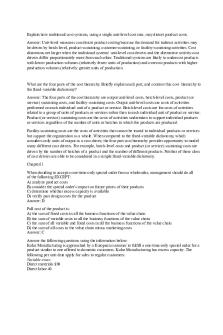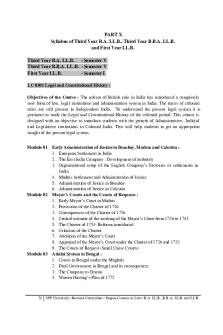Unit1 - NICE PDF

| Title | Unit1 - NICE |
|---|---|
| Author | Yellasiri Sangeetha |
| Course | Mechanical engineer |
| Institution | Rajiv Gandhi University |
| Pages | 58 |
| File Size | 3.4 MB |
| File Type | |
| Total Downloads | 59 |
| Total Views | 162 |
Summary
NICE...
Description
Compu
ments
What is Comput
ent? O O O b O b O b j b j b j e j e j e c e c e c t c t c t 5 t 6 t 7 8 9
When we want to solve a problem using a computer, the computer makes use of various devices which work together to solve that problem. There may be a various number of ways to solve a problem. We use the various number of computer devices arranged in different ways to solve different problems. The arrangement of computer devices to solve a problem is said to be a computing environment. The formal definition of the computing environment is as follows. Computing Environment is a collection of computers which are used to process and exchange information to solve various types of computing problems.
Types of Computing Environments The following are the various types of computing environments. 1. 2. 3. 4. 5. 6.
Personal Computing Environment Time-Sharing Computing Environment Client-Server Computing Environment Distributed Computing Environment Grid Computing Environment Cluster Computing Environment
Personal Computing Environment Personal computing is a stand-alone machine. In a personal computing environment, the complete program resides on the stand-alone machine and executed from the same machine. Laptops, mobile devices, printers, scanners and the computer systems we use at home, office are the examples for the personal computing environment.
Time-Sharing Computing Environment The time-sharing computing environment is a stand-alone computer in which a single user can perform multiple operations at a time by using a multitasking operating system. Here the processor time is divided among different tasks and this is called “Time-sharing”. For example, a user can listen to music while writing something in a text editor. Windows 95 and later versions of Windows OS, iOS and Linux operating systems are the examples for this computing environment.
Client-Server Computing Environment The client-server environment contains two machines (Client machine and Server machine). These both machines will exchange the information through an application. Here Client is a normal computer like PC, Tablet, Mobile, etc., and Server is a powerful computer which stores huge data and manages the huge amount of file and emails, etc., In this environment, client requests for data and server provides data to the client. In the client-server environment, the communication between client and server is performed using HTTP (Hyper Text Transfer Protocol).
Distributed Computing Environment In the distributed computing environment, the complete functionality of the software is not on a single computer but is distributed among multiple computers. Here we use a method of computer processing in which different programs of an application run simultaneously on two or more computers. These computers communicate with each other over a network to perform the complete task. In a distributed computing environment, the data is distributed among different systems and that data is logically related to each other.
Grid Computing Environment Grid computing is a collection of computers from different locations. All these computers work for a common problem. A grid can be described as a distributed collection of a large number of computers working for a single application.
Cluster Computing Environment Cluster computing is a collection of interconnected computers. These computers work together to solve a single problem. In a cluster computing environment, a collection of systems work together as a single system.
Introduction to C Programming C Programming Language is a very popular computer programming language through which users and computers can communicate. Using this series of tutorials, one can learn C Programming Language from the basics. Every topic in these tutorials is explained with clear information and good examples. The content of all the topics is prepared by very experienced and expert faculty.
What is C? C is a computer programming language used to design computer software and applications.
Why do we use C? We use the C programming language to design computer software and applications.
Who invented C? C Programming Language was invented in the year 1972 by Dennis Ritchie (Dennis MacAlistair Ritchie). He was an American Computer Scientist worked at Bell Labs as a researcher along with Ken Thompson. He was born on 9th September 1941 and lived till 12th October 2011. He is said to be the Father of C.
Computer Languages What is Computer Language? Generally, we use languages like English, Hindi, etc., to make communication between two persons. That means when we want to make communication between two persons we need a language through which persons can express their feelings. Similarly, when we want to make communication between user and computer or between two or more computers we need a language through which user can give information to the computer and vice versa. When a user wants to give any instruction to the computer the user needs a specific language and that language is known as a computer language. The user interacts with the computer using programs and that programs are created using computer programming languages like C, C++, Java, etc., Computer languages are the languages through which the user can communicate with the computer by writing program instructions. Every computer programming language contains a set of predefined words and a set of rules (syntax) that are used to create instructions of a program.
Computer Languages Classification Over the years, computer languages have been evolved from Low-Level to High-Level Languages. In the earliest days of computers, only Binary Language was used to write programs. The computer languages are classified as follows...
Low-Level Language (Machine Language) Low-Level language is the only language which can be understood by the computer. Binary Language is an example of a low-level language. Low-level language is also known as Machine Language. The binary language contains only two symbols 1 & 0. All the instructions of binary
language are written in the form of binary numbers 1's & 0's. A computer can directly understand the binary language. Machine language is also known as the Machine Code. As the CPU directly understands the binary language instructions, it does not require any translator. CPU directly starts executing the binary language instructions and takes very less time to execute the instructions as it does not require any translation. Low-level language is considered as the First Generation Language (1GL).
Advantages • A computer can easily understand the low-level language. • Low-level language instructions are executed directly without any translation. • Low-level language instructions require very less time for their execution.
Disadvantages • Low-level language instructions are very difficult to use and understand. • Low-level language instructions are machine-dependent, that means a program written for a particular machine does not execute on another machine. • In low-level language, there is more chance for errors and it is very difficult to find errors, debug and modify.
Middle-Level Language (Assembly Language) Middle-level language is a computer language in which the instructions are created using symbols such as letters, digits and special characters. Assembly language is an example of middle-level language. In assembly language, we use predefined words called mnemonics. Binary code instructions in low-level language are replaced with mnemonics and operands in middle-level language. But the computer cannot understand mnemonics, so we use a translator called Assembler to translate mnemonics into binary language. Assembler is a translator which takes assembly code as input and produces machine code as output. That means, the computer cannot understand middlelevel language, so it needs to be translated into a low-level language to make it understandable by the computer. Assembler is used to translate middle-level language into low-level language.
Advantages • Writing instructions in a middle-level language is easier than writing instructions in a lowlevel language. • Middle-level language is more readable compared to low-level language. • Easy to understand, find errors and modify.
Disadvantages • Middle-level language is specific to a particular machine architecture, that means it is machine-dependent. • Middle-level language needs to be translated into low-level language. • Middle-level language executes slower compared to low-level language.
High-Level Language A high-level language is a computer language which can be understood by the users. The high-level language is very similar to human languages and has a set of grammar rules that are used to make instructions more easily. Every high-level language has a set of predefined words known as Keywords and a set of rules known as Syntax to create instructions. The high-level language is easier to understand for the users but the computer can not understand it. High-level language needs to be converted into the low-level language to make it understandable by the computer. We use Compiler or interpreter to convert high-level language to low-level language. Languages like COBOL, FORTRAN, BASIC, C, C++, JAVA, etc., are examples of high-level languages. All these programming languages use human-understandable language like English to write program instructions. These instructions are converted to low-level language by the compiler so that it can be understood by the computer.
Advantages • Writing instructions in a high-level language is easier. • A high-level language is more readable and understandable. • The programs created using high-level language runs on different machines with little change or no change. • Easy to understand, create programs, find errors and modify.
Disadvantages • High-level language needs to be translated into low-level language. • High-level language executes slower compared to middle and low-level languages.
Understanding Computer Languages The following figure provides a few key points related to computer languages.
From the above figure, we can observe the following key points... • The programming languages like C, C++, Java, etc., are written in High-level language • • • •
which is more comfortable for the developers. A high-level language is closer to the users. Low-level language is closer to the computer. Computer hardware can understand only the low-level language (Machine Language). The program written in the high-level language needs to be converted to low-level language to make communication between the user and the computer. Middle-level language is not closer to both user and computer. We can consider it as a combination of both high-level language and low-level language.
Creating and Running C Program Generally, the programs created using programming languages like C, C++, Java, etc., are written using a high-level language like English. But, the computer cannot understand the high-level language. It can understand only low-level language. So, the program written in the high-level language needs to be converted into the low-level language to make it understandable for the computer. This conversion is performed using either Interpreter or Compiler. Popular programming languages like C, C++, Java, etc., use the compiler to convert high-level language instructions into low-level language instructions. A compiler is a program that converts high-level language instructions into low-level language instructions. Generally, the compiler performs two things, first it verifies the program errors, if errors are found, it returns a list of errors otherwise it converts the complete code into the low-level language.
To create and execute C programs in the Windows Operating System, we need to install Turbo C software. We use the following steps to create and execute C programs in Windows OS…
Step 1: Creating a Source Code Source code is a file with C programming instructions in a high-level language. To create source code, we use any text editor to write the program instructions. The instructions written in the source code must follow the C programming language rules. The following steps are used to create a source code file in Windows OS… • Click on the Start button • Select Run • Type cmd and press Enter • Type cd c:\TC\bin in the command prompt and press Enter • Type TC press Enter • Click on File -> New in C Editor window • Type the program • Save it as FileName.c (Use shortcut key F2 to save)
Step 2: Compile Source Code (Alt + F9) The compilation is the process of converting high-level language instructions into low-level language instructions. We use the shortcut key Alt + F9 to compile a C program in Turbo C. The compilation is the process of converting high-level language instructions into low-level language instructions. Whenever we press Alt + F9, the source file is going to be submitted to the Compiler. On receiving a source file, the compiler first checks for the Errors. If there are any Errors then compiler returns List of Errors, if there are no errors then the source code is converted into object code and stores it as a file with .obj extension. Then the object code is given to the Linker. The Linker combines both the object code and specified header file code and generates an Executable file with a .exe extension.
Step 3: Executing / Running Executable File (Ctrl + F9) After completing compilation successfully, an executable file is created with a .exe extension. The processor can understand this .exe file content so that it can perform the task specified in the source file. We use a shortcut key Ctrl + F9 to run a C program. Whenever we press Ctrl + F9, the .exe file is submitted to the CPU. On receiving .exe file, CPU performs the task according to the instruction written in the file. The result generated from the execution is placed in a window called User Screen.
Step 4: Check Result (Alt + F5) After running the program, the result is placed into User Screen. Just we need to open the User Screen to check the result of the program execution. We use the shortcut key Alt + F5 to open the User Screen and check the result.
Execution Process of a C Program When we execute a C program it undergoes with the following process… When we execute a C program it undergoes with the following process…
The file which contains c program instructions in a high-level language is said to be source code.
Every c program source file is saved with .c extension, for example, Sample.c. Whenever we press Alt + F9 the source file is submitted to the compiler. Compiler checks for the errors, if there are any errors, it returns a list of errors, otherwise generates object code in a file with name Sample.obj and submit it to the linker. The linker combines the code from specified header file into an object file and generates executable file as Sample.exe. With this compilation process completes. Now, we need to run the executable file (Sample.exe). To run a program we press Ctrl + F9. When we press Ctrl + F9 the executable file is submitted to the CPU. Then CPU performs the task according to the instructions written in that program and place the result into UserScreen. Then we press Alt + F5 to open UserScreen and check the result of the program.
Important Points • C program file (Source file) must save with .c extension. • The compiler converts complete program at a time from high-level language to low-level language. • Input to the compiler is .c file and output from the compiler is .exe file, but it also generates .obj file in this process. • The compiler converts the file only if there are no errors in the source code. • CPU places the result in User Screen window.
Overall Process • Type the program in C editor and save with .c extension (Press F2 to save). • • • •
Press Alt + F9 to compile the program. If there are errors, correct the errors and recompile the program. If there are no errors, then press Ctrl + F9 to execute/run the program. Press Alt + F5 to open User Screen and check the result.
C Background C is a structured programming language. It is also known as function orientated programming language. C programming language was developed in the year of 1972 by Dennis Ritchie at Bell Laboratories in the USA (AT & T). In the year of 1968, research was started by Dennis Ritchie on programming languages like BCPL, CPL. The main aim of his research was to develop a new language to create an OS called UNIX. After four years of research, a new programming language was created with solutions for drawbacks in languages like BCPL & CPL. In the year of 1972, the new language was introduced with the name “Traditional C”.
The name 'c' was selected from the sequence of previous language ‘B’ (BCPL) because most of the features of 'c' were derived from BCPL (B language). The first outcome of the c language was the UNIX operating system. The initial UNIX OS was completely developed using 'c' programming language. The founder of the ‘C’ language, Dennis Ritchie is known as “Father of C” and also “Father of UNIX”. The c programming language is very popular because it is reliable, simple and easy to use and it is the base for almost all the other programming languages. The following are the language before ‘c’ & various versions of ‘c’.
1. CPL (Common Programming Language) The CPL was invented by Martin Richards at the University of Cambridge in the early of 1960s.
2. BCPL (Basic Combined Programming Language) The BCPL was invented by Martin Richards at the University of Cambridge in the year of 1966. It was a popular programming language at that time. BCPL allows the user, direct access to the computer memory. BCPL is the extension of CPL.
3. B Language B language is derived from BCPL. It was introduced in the year of 1969 by Ken Thompson and
Dennis Ritchie at Bell Laboratory, USA. The B language is similar to BCPL.
4. C Language C language is derived from the B language. It was introduced in the year of 1972 by Dennis Ritchie at Bell Laboratory, USA. The C language was mainly developed to create an operating system called UNIX. The name C is given based on the previous language B and BCPL. Ninety percent of the UNIX operating system code is written in C language. During the 1970s, the C language became a very popular programming language. Many universities and organizations began creating their version of C language for their respective projects. So, C language has got many variants at that time. Later it was standardized.
5. ANSI C (C89) In the year of 1983, the ANSI (American National Standards Institute) formed a committee to frame standard specifications for the C language. In the year of 1989, this committee introduced a standard version of C with the name "ANSI C" with standard library files. The ANSI C is also called as C89 in short form.
6. C90 In the year of 1990, the ANSI C was got ISO (International Organization for Standardization) standardization with the inclusion of a few new features like new library files, new processor commands. And it was also added with keywords const, volatile and signed, etc... ISO standardized ANSI C as ISO/IEC 9899:1990. This version is called as C90 in short form.
7. C99 In the year of 1995, many new features were added to the C90 to create a new version of it. This new version of C was got ISO standardization in the year of 1999 with the name ISO/IEC 9899:1999. In the short form, it is called as C99. Later C99 became the official standard version of C.
C is a structured programming language. Every c program and its statements must be in a particular structure. Every c program has the following general structure...
Line 1: Comments - Th...
Similar Free PDFs

Unit1 - NICE
- 58 Pages

Ch11 - nice
- 16 Pages

Pythonlearn - Nice
- 249 Pages

A3P1 - Nice
- 13 Pages

Spm unit1
- 10 Pages

Unit1 - finite automata
- 72 Pages

Naasa - Nice
- 4 Pages

Etech 2 - NICE
- 85 Pages

Unit1 - notes handwritten
- 18 Pages

Unit1 Intro-1 - pratice
- 3 Pages

Dokument bez tytułu - nice
- 9 Pages

Manuale- NICE - BIO-FLO
- 1 Pages

Amcat automata 5 - Nice
- 2 Pages

Theory-jeemain - nice lectures
- 35 Pages

Llb syllabus 1 - Nice
- 4 Pages

Semana 6 - Nice
- 2 Pages
Popular Institutions
- Tinajero National High School - Annex
- Politeknik Caltex Riau
- Yokohama City University
- SGT University
- University of Al-Qadisiyah
- Divine Word College of Vigan
- Techniek College Rotterdam
- Universidade de Santiago
- Universiti Teknologi MARA Cawangan Johor Kampus Pasir Gudang
- Poltekkes Kemenkes Yogyakarta
- Baguio City National High School
- Colegio san marcos
- preparatoria uno
- Centro de Bachillerato Tecnológico Industrial y de Servicios No. 107
- Dalian Maritime University
- Quang Trung Secondary School
- Colegio Tecnológico en Informática
- Corporación Regional de Educación Superior
- Grupo CEDVA
- Dar Al Uloom University
- Centro de Estudios Preuniversitarios de la Universidad Nacional de Ingeniería
- 上智大学
- Aakash International School, Nuna Majara
- San Felipe Neri Catholic School
- Kang Chiao International School - New Taipei City
- Misamis Occidental National High School
- Institución Educativa Escuela Normal Juan Ladrilleros
- Kolehiyo ng Pantukan
- Batanes State College
- Instituto Continental
- Sekolah Menengah Kejuruan Kesehatan Kaltara (Tarakan)
- Colegio de La Inmaculada Concepcion - Cebu